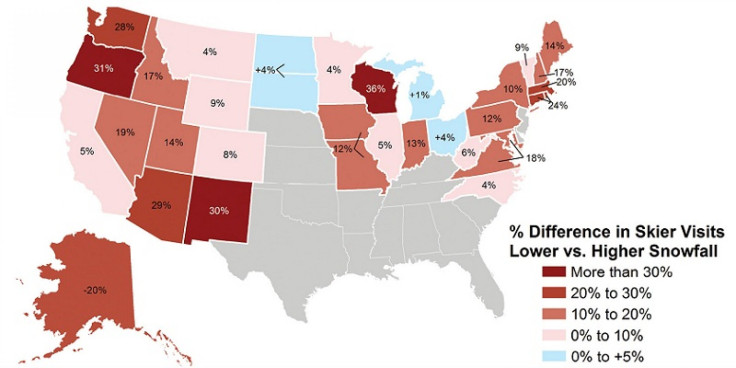Climate Change Has Cost Ski Industry $1B Already

According to a new economic analysis from nonprofit groups Protect Our Winters, or POW, and the Natural Resources Defense Council, or NRDC, the United States’ $12.2 billion winter tourism industry has experienced an estimated $1 billion loss and up to 27,000 fewer jobs over the last decade due to diminished snowfall patterns and the resulting changes of Americans’ outdoor habits.
The report’s authors, University of New Hampshire researchers Elizabeth Burakowski and Matthew Magnusson, warn that even tougher times could be in store for the industry “unless climate change is slowed, stopped and reversed.”
Winter temperatures are projected to warm by an addition 4 to 10 degrees Fahrenheit by the end of the century, leading to dramatic declines in snow cover and snowfall. According to the report, less snow equals shorter seasons, less jobs and a reduced economic output. In fact, the researchers warn that snow depths could decline by 25 percent to 100 percent in the West, while the length of the snow season in the Northeast could be cut in half.
Burakowski and Magnusson point to last winter as a prime example of what is happening. December 2011 to February 2012 was the fourth-warmest winter on record since 1896 and the third-lowest snow cover seen since satellites began tracking amounts in 1966. Some 50 percent of ski areas opened late, and 48 percent closed early, according to an industry survey.
“Snow is currency in the 38 states that benefit from winter tourism,” Burakowski said, and in many of those states, “climate change is expected to contribute to warmer winters, reduced snowfall and shorter snow seasons.
“This spells significant economic uncertainty for a winter sports industry deeply dependent upon predictable, heavy snowfall.”
Antonia Herzog, assistant director of the Climate and Clean Air Program at the NRDC, said shrinking numbers of tourists also hurt the bottom line of restaurants, lodging, gas stations, grocery stores and bars.
“For those whose livelihood depends upon a predictable winter season, such unpredictability and lack of snow can translate into a precipitous fall in revenue, an early economic indicator of what climate change looks like.”
The change in estimated visitors between high and low snowfall years during the last decade was more than -30 percent in states like Oregon and Wisconsin, with the traditional snow sports meccas of Colorado and Utah at -7.7 and -14 percent, respectively. The new report put the resulting difference in economic value added to the state economy at between -$117 and -$38 million and warned a bad year can spell a job loss for as many as 27,000 workers.
A team from the Web series Slow Ride Stories recently interviewed Russ Colton, CEO of Hunter Mountain Ski Resort in New York’s Catskill Mountains, and asked him if he believed humans had anything to do with the climate change.
“I don’t know that,” he said. “Obviously, there are a couple different schools of thought -- whether it’s developed by humans or whether it’s just a natural cyclical event that we’re going through.”
Auden Schendler, vice president of sustainability at Aspen Skiing Company, said this is indicative of the problem the industry faces from within.
“A CEO of a ski resort is fiscally obligated to know this, and the answer to that question enables you to solve it or not,” he said. “There really hasn’t been much of a response in the industry so far. In fact, it’s been rather defensive. People say, ‘the ski industry is doing just fine, by the way,’ which is a puzzling response.”
Schendler believes the industry “hasn’t done enough to educate its leaders about the raw science” and hopes the new report can finally put financial metrics behind what’s happening and motivate people to get to Washington, write op-eds and use their enthusiasm for snow sports to drive policy change “so we can ski for the next 100 years.”
© Copyright IBTimes 2024. All rights reserved.






















